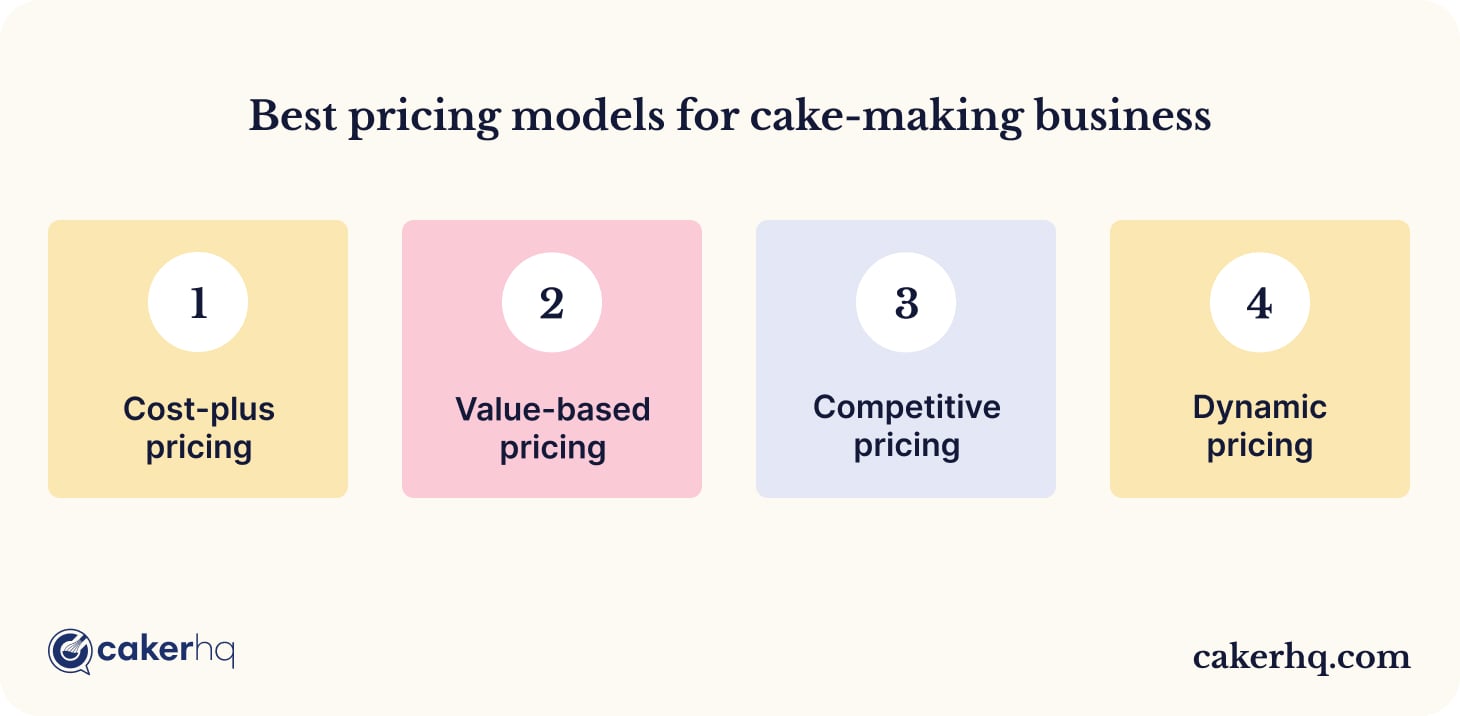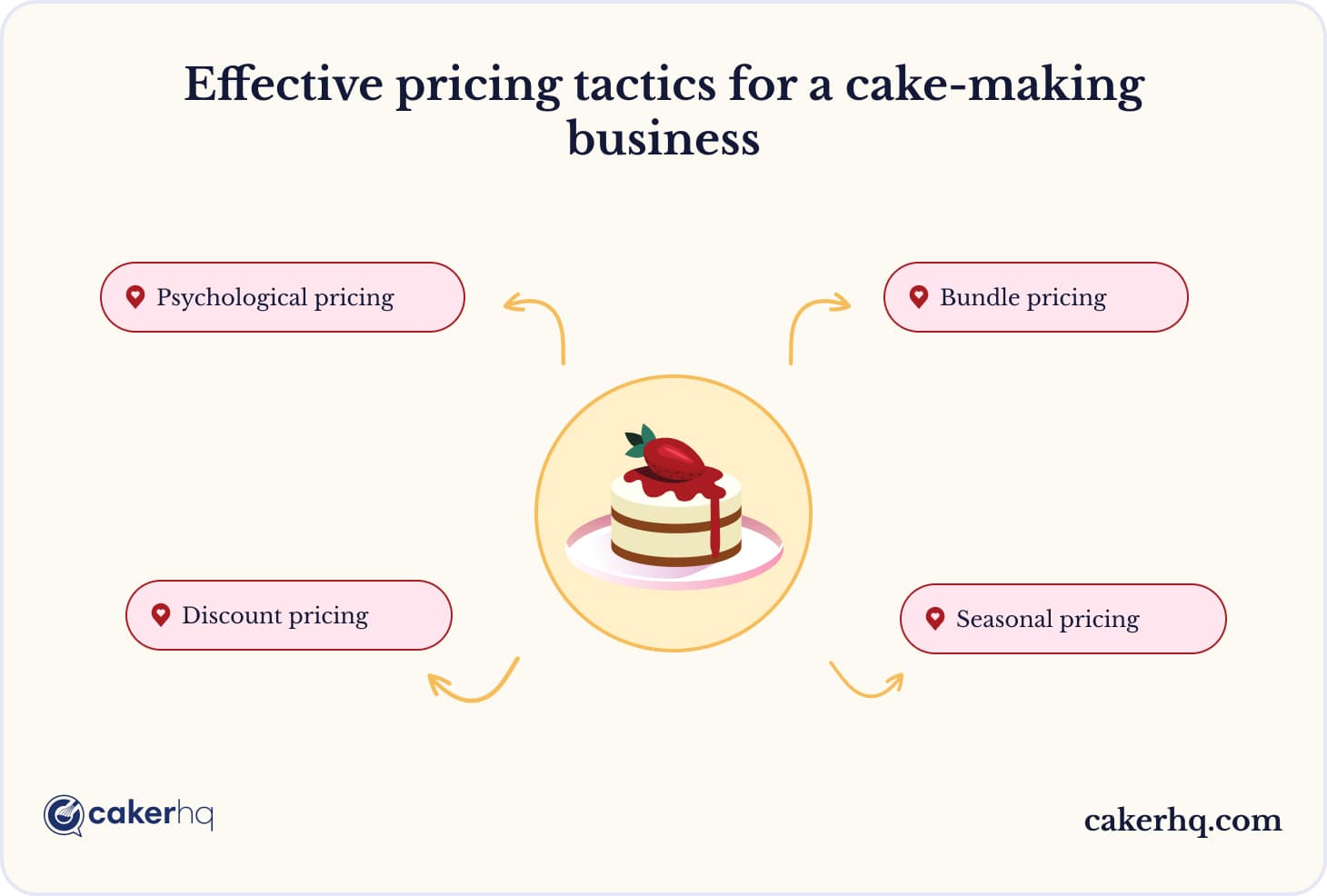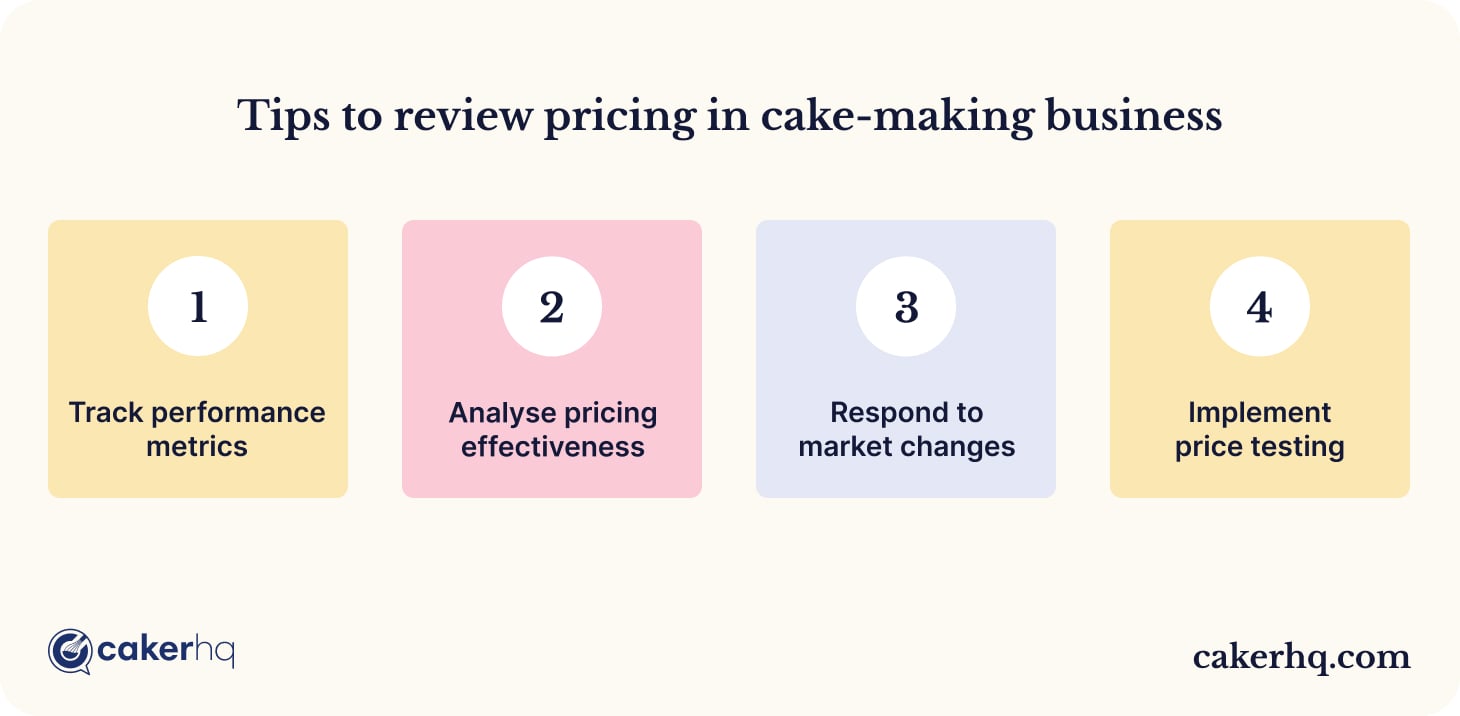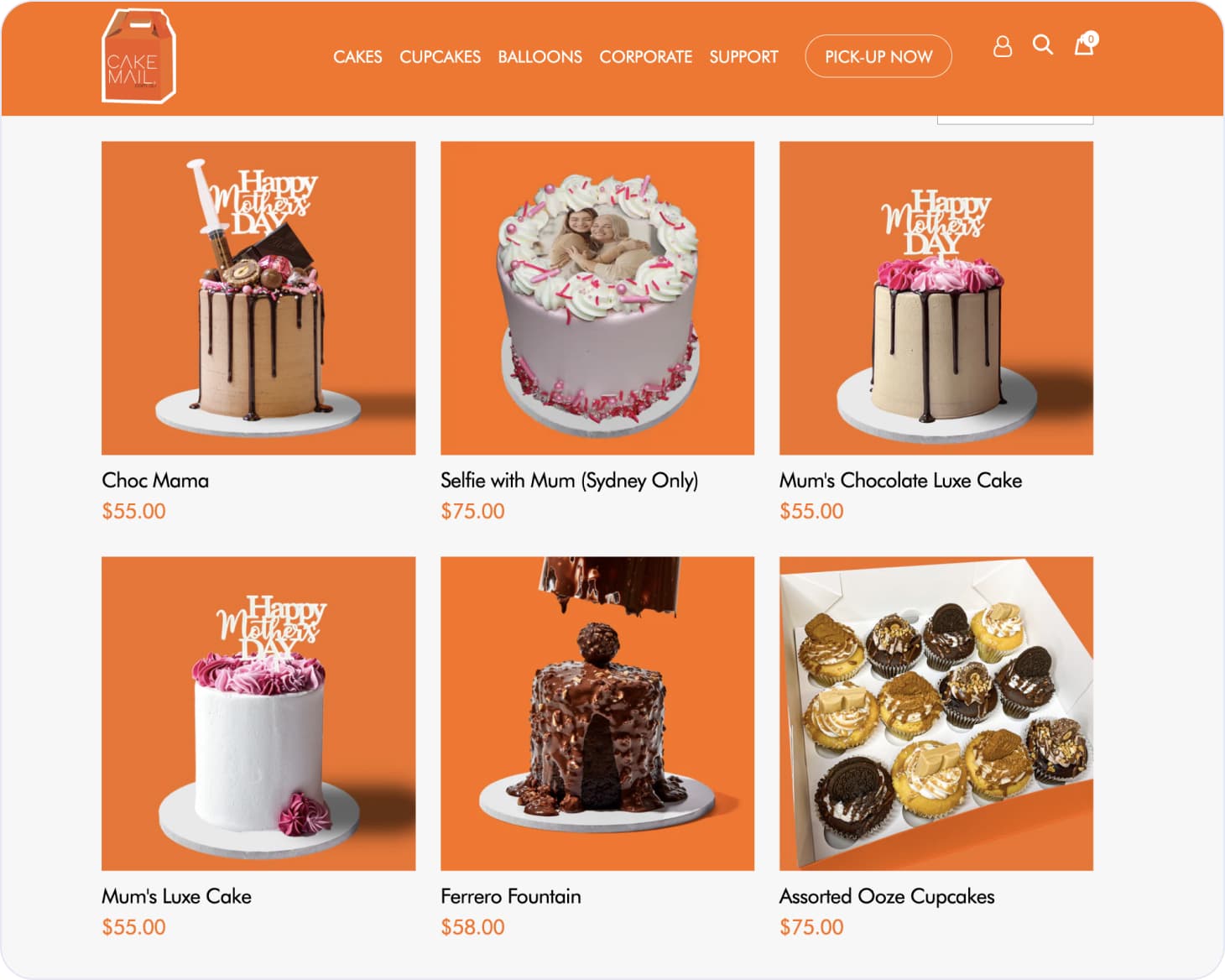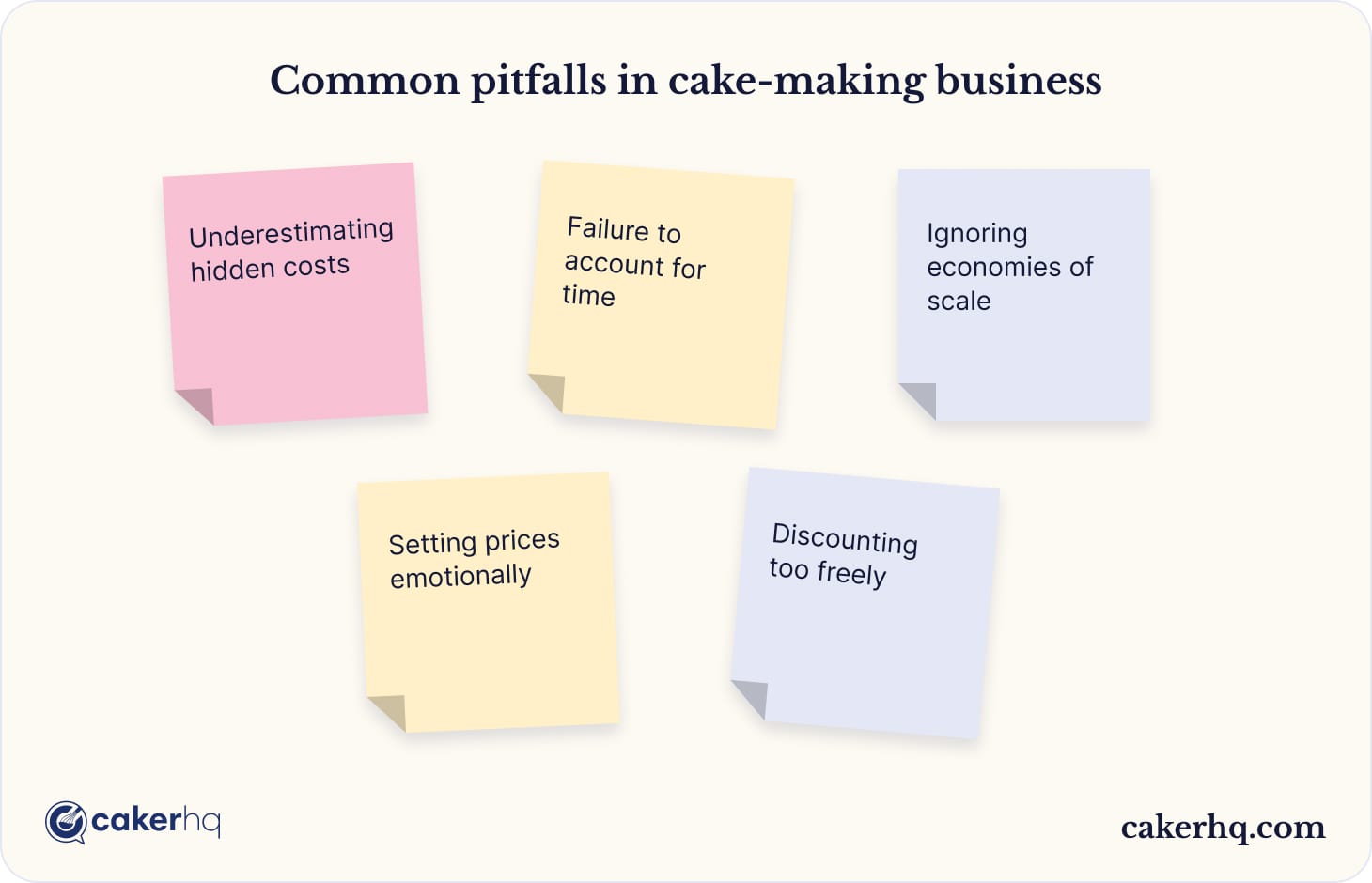Although appearing from a single idea seed, businesses are built brick by brick, and cake-oriented ones are no different. Earlier, we covered a lot of aspects about how to start a cake business, namely time management techniques, shipping, and development tactics.
In this article, we’ll cover pricing strategies. Thus, we’ll outline not only how to price baked goods but also more about different models, tactics, and ideas for you to consider when creating a cake-making business.
Understanding costs
Before we dive into how to price your cakes, tactics, ideas, and models, understanding costs that are all around the cake business is essential. Why? Well, profitability hinges on a clear understanding of the various cost components involved. Here's a breakdown of the key cost factors:
• Ingredients. This includes all the raw materials used in making the cakes, such as flour, sugar, eggs, flavorings, and decorations. It's crucial to track the cost of each ingredient per unit to calculate the total ingredient cost for each cake accurately.
In this regard, you can develop an advanced system to do so. For instance, you can use Google Sheets and basic Excel pages to keep track of things. Additionally, you can try out Notion, as it offers intuitive databases you can set up.
• Labour. The costs for labour costs encompass the wages or salaries of everyone involved in the cake-making process, including bakers, decorators, and assistants. Calculating labour costs requires considering both the time spent on each cake and each employee's hourly rate or salary. Even if you work alone, you should have a clear understanding of how much time costs, i.e., develop decent pricing for the time you spend on cake making.
• Overhead. In simple terms, overhead costs are the indirect expenses incurred in running the cake business, such as rent, utilities, equipment maintenance, insurance, marketing, and administrative expenses. These costs are typically allocated to each cake based on a predetermined overhead rate.
After all, calculating costs thoughtfully forms the foundation of effective pricing strategies in the cake business.
For instance, it improves your business’ profitability. Understanding costs enables your cake business to set prices that not only cover expenses but also generate a profit. Without knowing the true cost of producing each cake, it's impossible to determine whether prices are sufficient to achieve profitability.
Additionally, it helps in the competitive landscape. Understanding costs helps your cake business stay competitive by ensuring its prices align with or undercut competitors' prices while maintaining profitability.
Lastly, it is also about strategic decision-making. Thoughtful cost calculations provide valuable insights for strategic decision-making, such as identifying areas where costs can be reduced or efficiencies improved to boost profitability.
Market analysis
Frankly, you cannot create a pricing strategy for a cake-making business out of the blue. Quite the contrary, you need to make it based on the state of the market you’re entering. For this, you need market analysis, which can help in many ways.
Researching competitors' pricing strategies
Learning about your competitors can provide a lot of information, ideas, and ways to improve your own operations. To conduct a thorough analysis of competitors' pricing strategies, you can do the following:
• Identify key competitors. Start by identifying direct competitors—other cake businesses operating in the same market or serving a similar customer base. For instance, begin by analysing professionals' profiles on CakerHQ. Look at both local competitors and larger chains or online retailers.
• Analyse pricing structures. Examine their pricing structures, including base prices for different types and sizes of cakes, as well as any discounts, promotions, or special offers they may provide. Pay attention to factors like quality, customisation options, and brand reputation that may justify higher or lower prices.
• Understand positioning. Consider how competitors position themselves in the market. Are they positioning themselves as premium, mid-range, or budget options? Understanding competitors' positioning can help inform your own pricing strategy and differentiation efforts.
• Identify pricing trends. Look for patterns or trends in competitors' pricing strategies, such as seasonal fluctuations, responses to market changes, or pricing experiments. This can provide valuable insights into what pricing strategies are effective in the current market environment.
Identifying target market segments and their price sensitivity
Not all customers are the same when it comes to pricing sensitivity. Understanding the price sensitivity of different market segments allows your cake-making venture to tailor the pricing strategies to maximise revenue. Here's how to identify target market segments and their price sensitivity:
• Use market segmentation. Divide the market into distinct segments based on demographic, psychographic, behavioral, or geographic factors. Common segmentation criteria include age, income level, lifestyle, occasion, and purchasing behavior.
• Analyse price sensitivity. Assess the price sensitivity of each market segment by conducting surveys, interviews, or market research studies. Determine how willing customers in each segment are to pay higher prices for cakes and what factors influence their price perceptions.
• Use segment prioritisation. Prioritise market segments based on their size, growth potential, profitability, and alignment with your business's strengths and capabilities. Focus your pricing efforts on segments where you can capture the most value and achieve sustainable growth.
Analysing consumer preferences and trends in the cake industry
Perhaps this aspect is the most crucial of all three when it comes to market analysis. Consumer preferences and trends play a significant role in shaping pricing strategies in the cake-making market. To find out the preferences of your audience, you can do a lot of things.
Firstly, there’s a good old market research. The easiest way to do it is by asking for a feedback after purchases. Additionally, you can create online forms and ask customers to fill them. Lastly, there are always social media, where you can create polls, initiate discussions and ask for opinions.
Secondly, trends are another thing to stay updated about. Dedicated forums and communities can help you reveal a lot of information about trends. Thus, always look for patterns, such as popular cake flavours, designs, and decorating styles. Monitor social media platforms, industry publications, and trade shows for inspiration and insights.
Looking to create a cake-making business? Start with CakerHQ! Become a professional
Pricing models
Pricing is a critical aspect of any cake business's strategy, and choosing how to charge for a cake can have a significant impact on profitability and competitiveness. Here's an overview of how to price cakes based on four common pricing models used in the cake industry.
Cost-plus pricing
In a nutshell, cost-plus pricing involves calculating the total cost of producing a cake and adding a markup to determine the selling price.
On the one hand, this cake pricing model is simple and straightforward. Cost-plus pricing is easy to understand and calculate, making it suitable for businesses with straightforward cost structures. Additionally, it ensures cost recovery. By incorporating all costs into the pricing formula, cost-plus pricing ensures that the business covers its expenses and generates a profit.
On the other hand, this model doesn’t account for market demand. In this regard, cost-plus pricing can potentially lead to underpricing or overpricing. Also, it can limit your bakery cake pricing flexibility. Relying solely on cost-based pricing may limit the business's ability to respond to changes in the market or competition.
Fortunately, implementing this model is quite straightforward and can be done in three basic steps:
- Calculate total costs. Determine the total cost of producing each cake, including ingredients, labour, and overhead expenses.
- Add desired profit margin. Figure out the desired profit margin or markup percentage to add to the total cost.
- Set selling price. Calculate the selling price by adding the markup to the total cost.
Value-based pricing
The second model we’ll cover is value-based pricing, which involves setting prices based on the perceived value of the product to the customer rather than solely on costs.
First of all, to determine the value proposition of your cakes, you will need to understand the customer value. To do so, identify the unique features, benefits, and experiences that your cakes offer to customers. This may include quality, customisation options, brand reputation, preparation speed, and many other aspects.
Next, assess your customers’ willingness to pay. More specifically, determine how much customers are willing to pay for the value they perceive in your cakes. Again, to analyse this aspect, market analysis we covered earlier would be of great help.
Lastly, all that’s left to do is to set prices accordingly. Price your cakes based on the value they deliver to customers rather than solely on production costs. This allows you to capture more value and potentially command higher prices in the market.
Competitive pricing
Next up, competitive pricing involves setting prices based on the prices charged by competitors in the market. Implementing this model might be a little tricky as it involves a lot of competitor research we covered earlier.
Therefore, keep track of competitors' prices, promotions, and pricing strategies to understand their positioning in the market. Additionally, determine whether you want to price your cakes higher, lower, or at par with competitors based on factors such as quality, brand perception, and target market.
To make the competitive pricing work in your favour, differentiate your cakes based not only on market prices. Instead of solely competing on price, consider unique features you can offer, such as exquisite quality, fast shipping, or advanced decoration techniques, to justify higher prices and attract customers willing to pay a premium.
Dynamic pricing
In short, dynamic pricing involves adjusting prices in real-time based on changes in demand, supply, or other market conditions. To leverage this model properly, you will need to analyse a lot.
To start with, identify demand patterns. For instance, analyse historical sales data to identify patterns and trends in demand for your cakes, such as seasonal fluctuations or peak times.
Then, implement pricing algorithms. With proper pricing algorithms or software solutions, you can automate price adjustments. They, in turn, may fluctuate based on demand, inventory levels, or competitive dynamics.
Another thing that can help with dynamic pricing is special events. By utilising special events, you can make your cake-making business flexible enough to cater to different types of customers. For instance, you can start offering discounts, promotions, or special pricing for holidays, events, or special occasions to capitalise on increased demand and drive sales.
Pricing tactics
Moving from various pricing models, let’s cover the next important aspect, namely pricing tactics. These things can help you shape customer perceptions, influence buying behaviour, and maximise revenue for your cake businesses. Hence, let’s cover four of the most widespread ones.
Psychological pricing
This tactic involves setting prices in a way that taps into consumers' subconscious perceptions and influences their purchasing decisions. There are a few ways to leverage psychological pricing tactics.
• Charm pricing. Set prices just below a round number (e.g., $9.99 instead of $10) to create the perception of a lower price and increase purchase likelihood.
• Prestige pricing. Price certain cakes higher to create the perception of luxury, exclusivity, and superior quality.
• Price anchoring. Present higher-priced options first to anchor customers' perception of value, making subsequent options seem more affordable.
Bundle pricing
Bundle pricing involves offering multiple products or services together as a package deal at a discounted price compared to purchasing each item separately.
Source: Patisserie Valerie
To implement bundle pricing effectively, begin by choosing complementary products. Bundle cakes with items such as cupcakes, cookies, or beverages to enhance value and appeal to customers.
Furthermore, highlight savings people make by purchasing a bundle. Clearly communicate the discounted price and highlight the savings customers will enjoy by purchasing the bundle.
Additionally, offer customisation options for a bundle. Allow your customers to slightly customise bundle packages based on their preferences. For instance, you can let them choose different items in the same price category, choose flavours, fillings, decorations, packaging, and more.
Discount pricing
This tactic is practically one of the most popular in the market. Discount strategies are extremely effective for attracting customers, increasing sales volume, and clearing excess inventory. Here are some considerations for offering discounts:
• Limited-time promotions. Create a sense of urgency and encourage immediate purchase by offering discounts for a limited time. In this matter, you can set visible deadlines for a discount, or display the number of goods left.
• Volume discounts. Offer discounts for bulk purchases to incentivise customers to buy more cakes.
• Targeted discounts. Offer discounts to specific customer segments, such as first-time buyers, loyal customers, or members of a loyalty program. This will not only increase your sales but also make customers return and order more from you over time.
Seasonal pricing
Quite self-explanatory, seasonal pricing involves adjusting prices based on fluctuations in demand and supply throughout the year. Implementing seasonal pricing can be done in several steps.
First, identify peak seasons. These are special timeframes when demand for cakes is typically higher, such as weddings, birthdays, or major holidays like Christmas, Valentine's Day, or Easter.
Second, adjust prices accordingly. Increase prices during peak seasons to capitalise on increased demand and maximise revenue.
Lastly, offer promotions during off-peak seasons. During slower periods, offer promotions or discounts to stimulate demand and attract customers. This way, you will stay afloat in the market even during tougher times.
Tips for profitability
Pricing cakes for profitability is essential for the long-term success and sustainability of a cake-making business. Therefore, the venture's profitability is the first thing to prioritise when applying any pricing strategy. Here are a few tips to keep in mind.
Setting profit margins and revenue targets
As the heading suggests, one super helpful thing to do is to set profit margins and revenue targets. Let’s tackle it step-by-step.
Let’s begin with profit margins. Calculating them can greatly help you achieve your business goals. In this regard, consider overhead expenses, reinvestment needs, and desired return on investment. Typically, profit margins in the food industry range from 10% to 50%. Your profit margin should cover your costs, provide a return on investment, and support business growth.
Now, let’s move to revenue targets. These things should be aligned with your business objectives. For instance, they can be to achieve a certain level of profitability, fund expansion efforts, or increase market share. Additionally, break down your annual revenue target into monthly or quarterly goals for better tracking and management.
Need more revenue streams? Become a professional on CakerHQ. Sign up now
On a closing note, you can also make good use of pricing formulas. Developing them can ensure your selling prices generate the necessary profit margins to meet revenue targets while remaining competitive in the market.
In this regard, our cake pricing calculator can be of great help. It allows you to calculate quite accurate pricing for any cake you’re planning to make. Apart from simply adding ingredients, you can also add prices for each particular ingredient, its sizes/volumes, and its amount in the recipe. With all the details, this calculator provides quite accurate answers, saving you tons of time.
Monitoring and adjusting prices over time
Regularly updating your pricing and overall strategy based on performance and market changes is a completely natural thing for businesses to do. We’ve got a few tips for doing it properly.
• Track performance metrics. Monitor key performance indicators (KPIs) related to your pricing. They often include sales volume, revenue, profit margins, and customer feedback.
• Analyse pricing effectiveness. Evaluate the impact of pricing strategies on business performance and profitability, identifying areas for improvement or optimisation.
• Respond to market changes. Stay agile and responsive to changes in market dynamics, competition, and customer preferences by adjusting prices accordingly.
• Implement price testing. Conduct price testing experiments to gauge customer response to different pricing strategies and refine pricing tactics based on empirical data.
Strategies for increasing perceived value to justify higher prices
Prices growth is another natural thing for businesses, although people don’t like it. Therefore, there are tactics to employ that can help you negate the upsetting effect.
First of all, remember to emphasise quality and craftsmanship. After all, your cakes and other goods are hand-made based on custom recipes and high-quality ingredients. Thus, customers have to be reminded about it. Highlight the superior quality, freshness, and attention to detail that sets your cakes apart from competitors.
Additionally, showcase your expertise and creativity. The more you offer, the higher prices can be. Hence, show people your expertise and creativity, which results in your work. This way, you can position your cakes as premium offerings worth the higher price.
The customisation options you offer are another way to justify your custom cake pricing. The more exquisite your cake decorations and ideas are, the more people will be willing to pay. For instance, provide customisation options that allow customers to personalise their cakes to their preferences, adding value and justifying higher prices.
Source: Cake Mail
Lastly, do not neglect customer experience. People value everything, and when it comes to purchasing a cake, the entire process should be as pleasurable as possible for them. Hence, make sure you deliver exceptional customer service and convenience to enhance perceived value and justify premium pricing.
Common pitfalls
In any business type, possibilities for potential issues are endless. Therefore, learning them beforehand is essential. When developing a cake business type and how much to charge for cakes, there are some common pitfalls you ought to account for.
Underestimating hidden costs
Some costs may be overlooked or underestimated, leading to inaccuracies in pricing decisions. For example, you may change the ingredients supplier, whose prices are higher, or your new oven eats away way more power than your previous one. Remember, everything costs money. Thus, it's important to conduct a thorough analysis of all expenses, including both direct and indirect costs.
Failure to account for time
Time is money in the cake business, yet it's often overlooked when calculating how to price homemade cakes. Failing to accurately account for the time spent on each cake can result in underpricing and diminished profitability.
Ignoring economies of scale
As cake businesses grow, they may benefit from economies of scale, such as bulk purchasing discounts or increased production efficiency. Failing to adjust cost calculations to reflect these efficiencies can lead to suboptimal pricing decisions.
Setting prices emotionally
In small, home-based ventures, management and organisational aspects may not be as professionally thought-out as it is in full-fledged businesses. Allowing emotions, personal biases, or fear of losing customers to dictate homemade cake prices can result in pricing that does not reflect the true value of cakes and may lead to unsustainable pricing strategies.
Discounting too freely
Being generous and kind to your customers is always welcome and make no mistake, people will notice it. However, excessive generosity can make your business suffer. Offering discounts too liberally without considering the impact on profit margins or brand perception can devalue cakes and create an expectation of discounts among customers.
On a closing note, remember that everyone makes mistakes. It is absolutely OK as without dealing with problems, you won’t be able to learn. However, to avoid these pitfalls, invest time and resources into developing robust cost accounting systems and regularly reviewing and updating cost calculations to ensure accuracy and relevance. By doing so, you can lay a solid foundation for pricing strategies that drive profitability and long-term success.
Bottom line
Deciding how to price custom cakes in your business is a challenging task. Yet, without trying, it would be impossible to achieve something. Thus, we sincerely hope that some of the ideas, tactics, and strategies in this article have helped you compose your plan.
Once you’re done with developing a pricing strategy, there are aspects in business to consider as well. Thus, feel free to check out our blog, where we regularly cover everything about how to start a cake business. But, if you already have a thriving business, you can always expand it to CakerHQ by becoming a professional with us!

